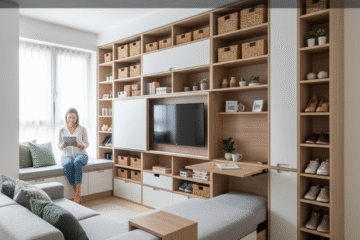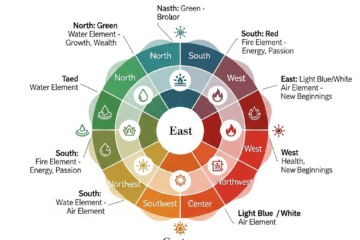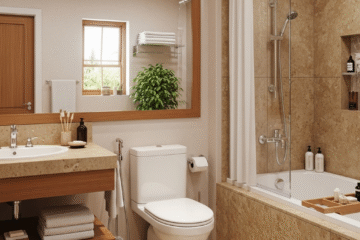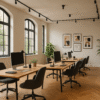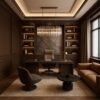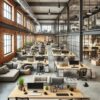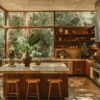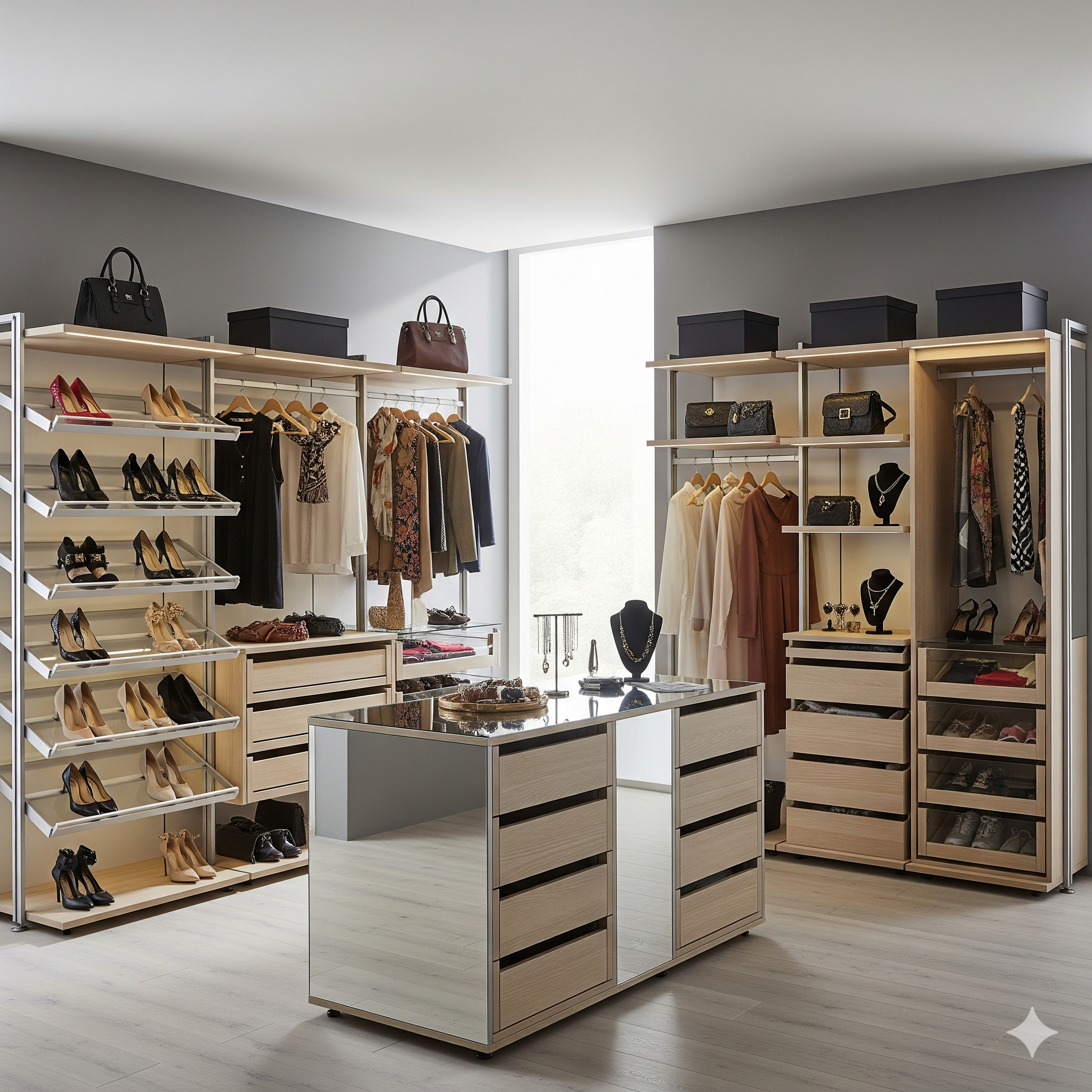
Modular Wardrobe Solutions
Modular Wardrobe Solutions: The Ultimate Guide to Smart Storage
In today’s urban lifestyle, where living spaces are shrinking and storage needs are growing, the demand for modular wardrobe solutions has never been higher. A wardrobe is no longer just a place to store clothes; it has evolved into a multifunctional storage system that reflects personal style, maximizes available space, and adapts to the changing requirements of modern households. Modular wardrobe solutions are at the forefront of this evolution.
The concept of customizable wardrobes combines flexibility, functionality, and aesthetics. Unlike traditional fixed wardrobes, customizable wardrobes are designed to fit into any space, big or small, while offering customizations that cater to individual needs. They can be expanded, reconfigured, or upgraded as requirements change, making them a long-term investment for homeowners and renters alike.
Table of Contents
Why Modular Wardrobe Solutions Are Essential for Modern Homes
The modern home demands smart storage, and modular wardrobe solutions provide just that. These wardrobes are tailored to optimize every inch of space, from floor to ceiling. They often include adjustable shelves, hanging rods, drawers, shoe racks, and accessory compartments. By offering this versatility, customizable wardrobes eliminate clutter and bring order to daily life.
Another important benefit is adaptability. Families grow, lifestyles evolve, and storage needs shift over time. With customizable wardrobes it’s easy to add new sections, adjust existing layouts, or reorganize compartments without replacing the entire structure. This adaptability saves money while keeping your interiors fresh and relevant.
The Aesthetic Impact of customizable wardrobes
Storage is not only about practicality—it’s also about style. customizable wardrobes elevate the look of a home by blending seamlessly into its design theme. From sleek glass doors to elegant wooden finishes, from minimalistic matte finishes to luxurious mirrored panels, modular wardrobes offer endless design options.
They can serve as focal points in bedrooms, walk-in closets, or dressing areas. In small apartments, modular wardrobe solutions often act as subtle room dividers, combining utility with design. By choosing the right finishes, colors, and handles, homeowners can ensure their customizable wardrobes align perfectly with the overall aesthetic of the home.
Types of Modular Wardrobe Solutions
- Sliding Door Wardrobes
Perfect for compact spaces, sliding door wardrobes save space by eliminating the need for swinging doors. They are sleek, modern, and available in multiple finishes. - Hinged Door Wardrobes
A classic choice that works well in larger spaces. Hinged wardrobes offer full visibility and accessibility, making them user-friendly. - Walk-In Modular Wardrobes
Ideal for spacious bedrooms, these wardrobes create a luxurious dressing space. They can be designed with dedicated areas for clothing, footwear, accessories, and even vanity counters. - Corner Wardrobes
Designed to utilize corner areas efficiently, corner modular wardrobes are great for maximizing underused spaces. - Floor-to-Ceiling Wardrobes
These wardrobes maximize vertical space, offering additional storage for seasonal items, suitcases, or rarely used belongings. - Open Modular Wardrobes
For those who prefer a modern, boutique-style display, open wardrobes offer an aesthetic appeal. They are great for showcasing clothing collections and are often used in contemporary interiors. - Customized Modular Wardrobes
From color to finish, handles to accessories, customized customizable wardrobes allow you to design every detail to fit your unique lifestyle.
Materials Used in Modular Wardrobe Solutions
The quality and durability of modular wardrobe solutions depend heavily on the materials used. Common options include:
- 1. Plywood – Strength and Durability
- Plywood is a versatile and durable material widely used in furniture and interior fittings. Its layered construction makes it strong, resistant to warping, and able to withstand moisture, which is ideal for kitchens, bathrooms, and wardrobes. Plywood also holds screws and fittings securely, ensuring longevity and stability in furniture pieces. Its natural wood finish provides a premium look, making it a preferred choice for high-quality interiors.
- 2. MDF and Particle Board – Cost-Effective Options
- MDF (Medium-Density Fiberboard) and particle board are popular choices for budget-friendly interiors. They are lightweight, easy to shape, and available in multiple finishes, such as laminates and paints. While they are less durable than plywood, MDF and particle board are ideal for decorative elements, modular furniture, and areas with lower moisture exposure. Their flexibility and affordability make them a practical choice for modern interior solutions.
- 3. Glass – Modern and Sleek Appeal
- Glass is used extensively in interiors to create a modern, sleek, and spacious feel. It is commonly combined with wood, metal, or aluminum to enhance aesthetics while maintaining functionality. Glass is ideal for partitions, cabinet doors, tabletops, and decorative panels. It reflects light effectively, making spaces appear brighter and more open.
- 4. Metal – Strength and Industrial Aesthetics
- Metal is a robust material that adds an industrial and contemporary look to interiors. Metals such as stainless steel, aluminum, and iron are widely used for furniture frames, shelving, handles, and accent pieces. Metal is strong, durable, and low-maintenance, providing structural integrity while complementing modern design styles.
- 5. Laminates and Veneers – Finishing Touches
- Laminates and veneers are widely used for finishing furniture and surfaces. They are available in a wide variety of textures, colors, and patterns, allowing for customization according to design themes. Laminates provide a durable and easy-to-clean surface, while natural veneers offer a luxurious wood-like appearance. These finishes enhance the aesthetics of interiors without compromising functionality.
Innovative Features in Modern Modular Wardrobe Solutions
Modern modular wardrobes are more than just shelves and drawers. Today’s designs integrate advanced features such as:
- 1. Pull-Out Shoe Racks
- Pull-out shoe racks maximize storage efficiency while keeping footwear organized and easily accessible. They prevent clutter at the bottom of the wardrobe, protect shoes from dust, and allow users to view all pairs at a glance. This feature is especially useful for households with multiple family members or extensive shoe collections.
- 2. Adjustable Hanger Rods
- Adjustable hanger rods provide flexibility for storing garments of different lengths, such as shirts, trousers, dresses, and coats. By allowing customization of hanging space, these rods make wardrobes adaptable to changing storage needs and enhance overall organization.
- 3. Built-In Lighting
- Built-in lighting inside wardrobes improves visibility, making it easy to locate clothing, accessories, and other items. LED strip lights or motion-sensor lights not only add convenience but also enhance the aesthetic appeal of the wardrobe interior. Proper lighting prevents accidental misplacement of items and adds a luxurious touch.
- 4. Drawer Organizers for Accessories
- Drawer organizers help keep ties, belts, jewelry, and other small accessories neatly arranged. They prevent tangling, misplacement, and clutter while making items easily accessible. Customized organizers improve functionality and contribute to a clean, tidy wardrobe space.
- 5. Mirror Panels Integrated into Doors
- Mirror panels integrated into wardrobe doors serve dual purposes: they provide a functional full-length mirror and visually expand the room. Mirrors make spaces appear larger and brighter, while eliminating the need for a separate dressing mirror, optimizing room layout.
- 6. Hidden Safes or Lockers
- Hidden safes or lockers provide secure storage for valuables such as cash, documents, and jewelry. Incorporating a discreet storage solution within the wardrobe ensures security without compromising aesthetics or accessibility.
- 7. Soft-Close Hinges
- Soft-close hinges enhance durability and create a quiet, premium experience. These hinges prevent doors from slamming, reduce wear and tear, and contribute to the longevity of the wardrobe. Soft-close mechanisms are particularly useful in households with children, preventing accidental injuries or damage.
These features not only improve functionality but also enhance the overall experience of using customizable wardrobes.
How Modular Wardrobe Solutions Enhance Smart Storage
One of the strongest advantages of customizable wardrobes is their ability to create smart storage zones. Clothes, accessories, shoes, and essentials each get a designated space. For instance, vertical compartments can store long coats, while horizontal drawers are perfect for folded clothes. Built-in racks keep shoes organized, while hidden drawers store jewelry and valuables securely.
This zoning ensures efficiency in daily routines. No more wasting time searching for misplaced items—modular wardrobe solutions keep everything organized and within reach.
Design Inspirations for Modular Wardrobe Solutions
Minimalist Scandinavian Style
Clean lines, neutral tones, and functional layouts define this style. Customizable wardrobes in Scandinavian designs bring simplicity and efficiency.
Luxury Walk-In Wardrobe
For those who crave sophistication, a walk-in modular wardrobe with glass doors, accent lighting, and open displays creates a luxurious experience.
Compact Urban Wardrobe
Perfect for apartments, compact customizable wardrobes with sliding doors and mirrored panels save space while adding depth to the room.
Industrial Chic Wardrobe
Exposed metal frames, matte finishes, and neutral shades make this style bold and modern.
The Role of Modular Wardrobe Solutions in Sustainable Living
Sustainability is not just a design trend anymore—it’s a necessity. Homeowners are increasingly conscious of reducing waste, choosing eco-friendly materials, and investing in long-lasting solutions. One of the most practical ways to bring sustainability into your interiors is by adopting modular wardrobe solutions. These wardrobes not only enhance functionality and aesthetics but also support sustainable living by minimizing waste, using greener materials, and extending product life cycles.
Why Modular Wardrobe Solutions are Eco-Friendly
Unlike traditional wardrobes that are built-in and rigid, modular wardrobes offer flexibility and longevity. Their eco-friendly nature lies in their adaptability and design:
1. Minimized Waste Through Replaceable and Reconfigurable Parts
Modular furniture is designed to minimize waste by allowing individual parts—such as doors, shelves, or panels—to be replaced or reconfigured without discarding the entire unit. Unlike traditional furniture, which often ends up in landfills when damaged or outdated, modular systems reduce material wastage and promote a longer, more efficient usage cycle.
2. Use of Sustainable Materials
Many modular furniture units are crafted from sustainable materials such as bamboo, reclaimed wood, or eco-certified laminates. These materials not only reduce the environmental impact of production but also offer durability and aesthetic appeal. By opting for modular furniture with responsibly sourced materials, homeowners contribute to eco-friendly living practices and support sustainable interior solutions.
3. Longer Lifespan Reduces Frequent Replacements
Modular furniture is built for longevity. Its ability to adapt to changing needs—through reconfiguration, expansion, or component replacement—means it doesn’t need to be replaced as frequently as conventional furniture. This extended lifespan reduces resource consumption and overall environmental impact, making modular systems a sustainable and cost-effective choice for modern homes.
Modular Wardrobe Solutions and Waste Reduction
One of the biggest environmental challenges in furniture is waste. Traditional wardrobes often get discarded when a single part is damaged or when homeowners want a new layout. In contrast, modular wardrobes:
- 1. Easy Replacement of Damaged Sections
- One of the biggest advantages of modular wardrobes is that they allow you to replace only the damaged section, such as doors, shelves, or panels. Unlike traditional wardrobes, you don’t need to discard the entire unit if one component wears out or gets damaged. This not only saves money but also reduces waste, making modular wardrobes a practical and long-term investment for any home.
- 2. Reconfigurable Design for Changing Needs
- Modular wardrobes are highly adaptable. They enable reconfiguration if your storage needs evolve over time—for example, turning a two-door wardrobe into a three-door unit, adding additional drawers, or modifying hanging sections. This flexibility ensures that your wardrobe grows with your lifestyle, accommodating new clothing, accessories, or seasonal storage requirements without the need for a full replacement.
- 3. Support for a Circular Economy
- Modular wardrobes contribute to sustainability by supporting a circular economy. Old parts, panels, or accessories can be recycled or reused instead of being discarded. This environmentally friendly approach reduces the carbon footprint associated with furniture production, promotes responsible consumption, and aligns with modern eco-conscious living practices.
This waste reduction makes modular wardrobe solutions an essential part of sustainable interior design.
Sustainable Materials in Modular Wardrobe Solutions
Another way these wardrobes promote sustainable living is through material selection. Manufacturers are now prioritizing green materials, such as:
- Bamboo: A fast-growing, renewable resource.
- Reclaimed wood: Reduces deforestation and gives old wood new life.
- Eco-friendly laminates: Made with low-VOC adhesives to reduce indoor pollution.
- Recyclable metal and glass: For wardrobe frames and shutters.
Choosing the right materials not only makes your modular wardrobe durable but also significantly reduces environmental impact.
Durability and Longevity of Modular Wardrobe Solutions
Durability is at the heart of sustainability. When furniture lasts longer, fewer resources are needed for replacements. Modular wardrobes are:
- Built with high-quality hardware and finishes that withstand daily use.
- Easy to upgrade or expand, avoiding the need for full replacements.
- Designed to evolve with lifestyle changes—whether you’re moving houses, upgrading storage, or shifting room layouts.
This adaptability ensures your investment lasts for years, promoting sustainable consumption.
Space Optimization for Sustainable Living
A lesser-discussed advantage of modular wardrobe solutions is space efficiency. When wardrobes maximize available space:
- Homeowners avoid buying excess furniture.
- Smaller, efficient spaces reduce the overall energy footprint of a home.
- Built-in storage eliminates clutter, aligning with minimalist and eco-conscious living.
Modern Design Meets Sustainability
Today’s modular wardrobes are not just practical—they’re stylish. With a wide variety of finishes, sliding or hinged doors, open shelving, and customized layouts, they combine:
- Aesthetic appeal with eco-friendly materials.
- Smart designs that adapt to modern apartments and compact homes.
- Choices that align with both luxury and sustainable goals.
This makes modular wardrobes a perfect blend of beauty and responsibility.
🌱 Ready to make your interiors eco-friendly?
Explore modular wardrobe solutions at InteriorGrid.com and take a step towards sustainable living today!
The Cost-Effectiveness of Modular Wardrobe Solutions
Sustainability is often seen as expensive, but modular wardrobes prove otherwise. Over time, they save money by:
- Reducing the need for replacements.
- Allowing upgrades instead of complete purchases.
- Lowering maintenance costs due to durable designs.
Thus, sustainability and affordability go hand in hand with modular wardrobes.
External Resources on Sustainable Furniture
Internal Resources from InteriorGrid
- Smart Storage Solutions for Small Bedrooms
- Eco-Friendly Interior Design Trends
- Guide to Choosing Modular Kitchen Designs
♻️ Want a wardrobe that evolves with your lifestyle?
Connect with InteriorGrid.com for customized modular wardrobe solutions tailored to your sustainability goals.
FAQs on Modular Wardrobe Solutions and Sustainability
Q1: Are modular wardrobes really eco-friendly?
Yes, because they use sustainable materials, minimize waste, and last longer.
Q2: Can I recycle old modular wardrobe parts?
Most parts can be reused, recycled, or upgraded.
Q3: Are modular wardrobes expensive?
Not necessarily. They offer long-term savings compared to traditional wardrobes.
Q4: What is the best material for sustainable wardrobes?
Bamboo, reclaimed wood, and eco-certified laminates are top choices.
✨ Make your home stylish, functional, and green!
Choose modular wardrobe solutions with InteriorGrid.com and embrace sustainable living today.
Cost Considerations for Modular Wardrobe Solutions
The cost of modular wardrobe solutions varies based on size, material, design, and features. On average:
- Basic modular wardrobes start at affordable ranges, making them accessible to budget-conscious homeowners.
- Mid-range wardrobes with premium finishes and features are popular among urban households.
- Luxury wardrobes with walk-in designs, glass finishes, and integrated lighting represent the higher end of the spectrum.
While the initial cost might seem higher than traditional wardrobes, modular wardrobe solutions offer better value due to their adaptability and durability.
Future Trends in Modular Wardrobe Solutions
- Smart Wardrobes
Integration of technology such as digital locks, automated lighting, and sensors that track clothing usage. - AI-Powered Organization
Wardrobes that suggest outfits based on weather, occasion, and personal style preferences. - Eco-Friendly Materials
Greater use of recyclable and sustainable materials in modular wardrobe solutions. - Hybrid Designs
Wardrobes that combine open display areas with closed storage, offering both aesthetics and utility.
Conclusion
Modular wardrobe solutions represent the perfect balance of functionality, style, and adaptability. They offer smart storage, enhance daily living, and bring aesthetic value to modern homes. Whether you live in a compact apartment or a spacious villa, modular wardrobe solutions can be tailored to your needs. With their flexibility, durability, and design versatility, they are a must-have in today’s interiors.
As the future of storage design evolves, modular wardrobe solutions will continue to dominate the market with innovations in technology, sustainability, and customization. For homeowners seeking efficiency, elegance, and long-term value, modular wardrobe solutions are the ultimate investment.

